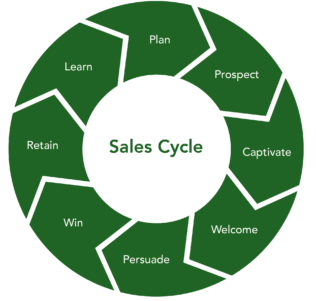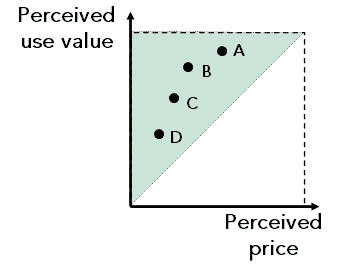The sales cycle, a new approach to avoid commoditization and boost growth


Imagine that your sales team avoids commoditization. Would that boost growth in your company?
Avoiding commoditization is not impossible, but you need the right tools. One of them is the sales cycle.
A few stories
Some time ago, I was telling one of my clients – an architecture firm – that writing good looking proposals was not enough to win consistently and generate growth. The marketing director contested me and showed a brochure they used to explain their potential clients the best approach to build constructions:
1. Make a general description of the intended construction.
2. Write the terms of reference to invite architecture firms to design the project and accompany the construction work.
3. Select the best architecture firm.
4. Accompany and validate the design of the project.
5. Validate the terms of reference for the construction work.
6. Select the best construction firm.
7. Accompany the construction work.
He explained that the key issue was number 3, they needed excellent proposals to win and therefore my suggestion didn’t make sense. Then I asked him a few questions:
- Is your firm growing? He said no, not for the last 3 years.
- How many partners did you promote in the last 5 years? He said none.
- How do you obtain leads? He said the partners made lots of social contacts.
- And do you have price pressure from clients? He said yes, they struggled to deliver the best full-of-innovation proposals, but they almost always had to make discounts to win projects.
At another client, a highly respected law firm, I asked one of the most prestigious partners if they had price pressure from clients. He said yes and no. Yes from new clients, no from existing ones. Then I asked him a few questions:
- Are you expanding the client base? He said they wanted to, but they were not competitive.
- Do you know the reasons why you lose? He answered price.
- Do you know the reasons why you win? He said it was because of the quality of service in existing clients and because of low price in new clients.
- Have you ever asked that to your clients? He said no, it was his impression.
- Do you discuss the reasons for winning and losing with your team? No.
- And with the client? He answered he was afraid of doing so. When they lose, they don’t have the opportunity, when they win it can be counterproductive.
Yet at another client, a car importer and distributor, I asked the sales director the percentage of sales they had from existing and new clients. He said they didn’t know. Then I asked him a few questions:
- Do your intermediaries’ sales teams complain about the high price of your cars? He said yes, all the time. And they were forced to offer discounts almost on every sale because salespeople keep saying that the client decides based on price.
- Is your advertising expenditure higher or lower than your competitors’ in percentage of revenue? He answered that it was higher than most.
- How do your margins compare to importers of your brand from other countries? He told me the margins were lower than average.
- And do you have a loyalty program? No.
All these stories have two things in common, the companies don’t have a complete view of the sales process and they suffer from commoditization. Naturally, both are interconnected.
In the architecture firm, the brochure revealed a commodity mindset. They were neglecting a very important part of the sales process (1 and 2), leaving it to their competitors. They needed to focus on market segments where they were more competitive and create a serious prospecting practice, which also required some investment on marketing communication.
In the second case, the law firm was good at retaining the clients through excellent service, but they were not learning how to win new clients without going into the price war of commoditization. They needed to improve their captivation skills, promote recommendations from their clients and create a learning practice to be able to expand the client base.
In the third case, the company was permanently under a commodity war. They needed to improve their captivation and persuasion skills and to create a loyalty program to mitigate the price sensitivity of their clients and promote repeat sales.
The sales cycle
Avoiding commoditization is difficult, you can’t wing it. The only way is having a systematic marketing and sales approach. It doesn’t matter if your sales channel is B2B or B2C, you must perform all the activities needed to excel in sales. Hence the sales cycle.

The sales cycle represents the life cycle of every marketing campaign, from planning up to learning from its execution and its outcome.
The sales cycle has different activities:
ACTIVIDADE | DESCRIÇÃO |
|---|---|
PLAN | To plan means to define the marketing campaign. The ultimate goal is to lay down the conditions for the success of the campaign. It doesn’t matter if your sales channel is B2B or B2C, you must define name, description, intent, focus, objectives, target segments, sales channels, products and their life cycles, prices and special conditions, calendar, budget and communication briefing for every marketing campaign. |
PROSPECT | |
CAPTIVATE | To captivate means to attract and hold the attention of prospects. The ultimate goal is to make the prospective client start a sales interaction. Awareness, interest and desire communication campaigns (the first three of the famous and still valid AIDA model) are used to lead the client to start an interaction with a salesperson (through email, social media message, phone message, mail, phone call, or visit) or to start a buying sequence on the company’s online store. It doesn’t matter if your sales channel is B2B or B2C, you must communicate with clients (directly through communications systems or indirectly via media platforms) before they initiate the buying process. |
WELCOME | To welcome means to greet the arrival of prospects with pleasure or kind courtesy. The ultimate goal is to qualify the sales opportunity. In B2B channels the qualification is a very important decision, because developing winning proposals requires lots of time and resources. In B2C channels the qualification is done almost automatically in most cases and companies don’t even acknowledge that there is a decision to be taken, but sometimes you need to assess if you should spend time dealing with the prospective client. Some B2C companies with a cost-cutting mindset stopped doing the welcome activity with the advent of self-service, but today we have technology available to do it without increasing cost, for instance an app guide in a supermarket. |
PERSUADE | To persuade means to convince prospects to act. The ultimate goal is to convince the client to buy. In B2C sales channels the activities welcome, persuade and win are generally performed in one single contact, but they occur in that sequence during the contact. In B2B sales channels, several contacts are needed with different people before presenting a winning proposal to the client, which is the final step of this activity. |
WIN | To win means to close the sales opportunity successfully. The ultimate goal is to conclude a sales transaction with the client. In B2B sales channels this activity includes negotiation before signing a contract in most cases. In B2C sales channels sometimes a negotiation also takes place before finalizing the transaction. |
RETAIN | To retain means to keep in mind. The ultimate goal is to facilitate future sales. Keep in mind goes both ways, for the client and for the company. If employees keep the client in mind in everything they do, client service will tend to be excellent and become part of the company’s culture. If clients keep the company in mind, they will become loyal. But client service is not the only loyalty enabler, another very important one is exclusivity. Top B2C companies offer exclusive conditions for their loyal clients. Top B2B companies progress on the client relationship continuum until becoming trusted business partners/advisors. |
LEARN | To learn means to gain knowledge, understanding and skills by analyzing and reflecting upon the marketing campaign experience and its outcome. The ultimate goal is to excel in sales. Learning is a team endeavor, it requires constant monitoring, discussion and analysis of successes and failures and sharing of insights with the marketing and sales teams. |
The sales cycle is supported in CRM systems via the sales funnel. Different companies and sales channels have different sales funnel stages for their sales opportunities. In B2B several contacts are needed to win a sale and therefore there are many stages. In B2C one contact is all it takes to welcome, persuade and win a sale in most situations, so there are fewer stages. And the same applies to online sales. In all of these cases, when compared to current practice, additional stages must be added to the sales funnel to register relevant information relating to the activities retain and learn.
What about B2B2C and B2B2B? The sales cycle is entirely applicable for the process of establishing a distribution contract with an intermediary. However, for ongoing sales activities, it is necessary to use the the channel cycle.
The sales funnel leaks both in B2C, B2B and B2B2x, it is impossible to win every time. This means that the sale opportunity may fall off the funnel (lost or abandoned). But it doesn’t mean that the client (or prospective client) will abandon the marketing pyramid. No, the client’s contact will be used to plan future marketing campaigns, possibly in a different pyramid level.
Avoiding commoditization
Sometimes salespeople forget about the basic requirement to win a sale. Consider the diagram below:

The client buys only if the perceived use value is higher than the perceived price (the green part), which means that the client has a surplus. On the other hand, clients decide based on different criteria, therefore any competitor can win. Competitor A wins if the criterion is higher perceived use value, competitor B wins if the criterion is the ratio between perceived use value and perceived price, competitor C wins if the criterion is higher perceived use value with perceived price lower than a threshold between B and C and competitor D wins if the criterion is lower perceived price (if your company is the low price leader, you can play the commodity game, but you can’t ignore value because you still need a client surplus to win).
This diagram illustrates that value must always be present, starting with the choice of the right (valuable) clients to work with and continuing with all activities in the sales cycle.
Companies have several benefits by using the sales cycle for every marketing campaign:
- Choosing the right targets (some are not worth working with).
- Maximizing reach and frequency of contact for the chosen targets by developing an integrated communication plan agreed between marketing and sales.
- Qualifying the sales opportunities (some are better left for competitors).
- Persuading the client to buy based on value, not on price.
- Promoting loyalty immediately after winning, which leads to repeat sales and recommendations for other clients.
- Learning as a team to improve constantly in every activity.
- Managing sales effortlessly and easily spotting good and bad practices, thanks to a uniform framework for measuring success across all sales channels.
The combined effect of these benefits is boosting growth. Your sales organization starts to function like a machine, with all its components perfectly aligned.
In addition, the sales cycle has a visual advantage. Sales is no longer a process with beginning and end, but rather an endless cycle of continuous improvement favored by the learning activity, which provides input for planning the next marketing campaign and therefore choosing the right target clients.
Conclusion
The sales cycle is an innovative concept, based on years and years of research of best practices around the world in every type of business. By implementing it, companies develop an important tool to gain competitive advantage over their competitors. Marketing and sales teams work together to define sales targets, plan and execute marketing communication campaigns, win sales opportunities based on value, promote loyalty and learn continuously. In addition, the sales cycle provides the base for easily managing the business.
Now you don’t have to struggle with commoditization, you know how to concentrate on value and boost growth at your company.
Filipe Simões de Almeida
Managing Partner, Fi Consulting
Posted on 26-Jul-2021
